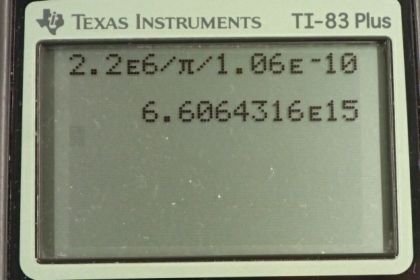a)
b)
Solution video
OpenStax College Physics, Chapter 2, Problem 15 (Problems & Exercises)

Calculator Screenshots
Comments
Why did you divide pi from the 2r value? Shouldn't it be multiplied instead?
Hi nicholebondurant, thanks for the question. I'm seeing pi multiplied by 2r, as you're correctly suggesting. This is to find the circumference so that we can multiply the distance traveled in one second by 1 revolution per circumference in order to calculate the number of revolutions in a second. Where, specifically, in the video did you notice dividing pi from the 2r? If you could give a video timestamp, that might be helpful.
All the best,
Shaun
3:03min shouldnt the 2.20E6 be divided by pi. And pi should be multiplying the 1.06E-10 however the way you entered it in the calculator you are dividing everything. I am missing something? My confusion comes from the calculator snapshots and because if I were to set up that specific calculation from minute 3:03 in the way it is specified in the video they I get another answer..
Ah, I understand where you're coming from now. What you're seeing in the calculator screenshot is a different way of entering what you're expecting. Just to use simpler number for ease of typing, here are the two ways of entering the same calculation:
Version A: 12/(2*3). This is the style that's written in the video, and you're expecting to see this in the calculator screenshot.
Version B: 12/2/3. This is the style that I tend to type in my calculator, for no reason other than personal preference. The calculator always evaluates left to right, meaning that 12 with be divided by 2 first, and that result (namely, 6), will then be divided by 3, resulting in the same answer as for version A, which is 2.
If you have a more modern calculator than my TI-83, and yours displays fractions, I would suspect that when you try entering the same as Version B, that you might in fact be doing the calculation 12/(2/3), which is not the correct calculation.
Hope this helps, and thanks for the question,
Shaun


